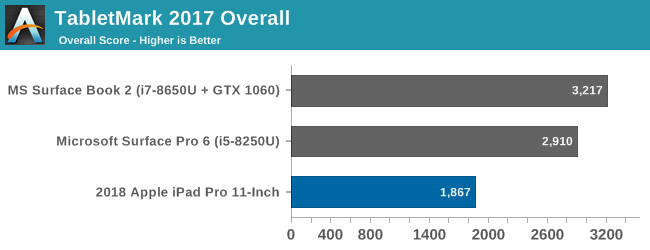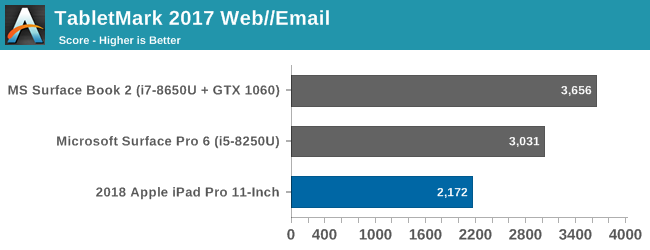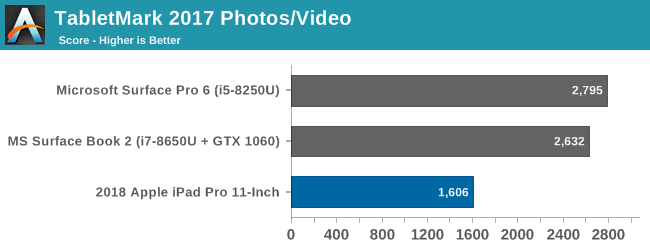The 2018 Apple iPad Pro (11-Inch) Review: Doubling Down On Performance
by Brett Howse & Andrei Frumusanu on December 4, 2018 10:00 AM ESTTesting Notes
Before diving into the nuts and bolts of our actual review, I wanted to stop for a moment and talk about the means and perspectives on how to best test Apple’s rather unparalleled tablet. In terms of mechanical benchmarks, the path is rather straightforward – almost frustratingly so. There are only so many decent standardized benchmarks that run on the iPad Pro, and even fewer of those that overlap with other operating systems, particularly windows. This is why, as atypical and throughput-focused as SPEC is, it remains one of the better tools for determining how the hardware compares to other devices.
However when it comes to the user experience, that’s another matter. The iPad Pro is an iPad, that is also Pro. Specifically, that it has been designed and is being specifically pitched not only as a tool for the iPad’s traditional content-consumption tasks, but also professional productivity use cases as well. Document editing, content creation, photo editing, and other tasks that while not outside of the realm of a regular iPad, aren’t really its forte either.
Since there aren’t really any other serious Arm-based tablets of the iPad Pro’s caliber on the market – Android seems to slip farther and farther behind every year – for the review of this year’s significantly redesigned model, I’m opting to approach matters from the other direction: how does it compare to traditional productivity machines. This is the market occupied by the likes of the Microsoft Surface Pro and other Windows-powered convertibles; devices that have brought the Windows experience to a tablet-like form factor. And while the overlap is by no means perfect, I do feel that these sorts of devices are the standard-bearers for productivity and professionally-oriented tablets on the whole.
So at least in my eyes, the real competition for the new iPad Pros is going to be these other pro devices, rather than a smattering of large-format Arm-based tablets. And these are the sorts of devices I’m primarily going to be looking to compare the iPad Pro against.
System Performance
There’s little doubt that Apple has crafted a great SoC with the A12X, offering an eight core CPU for the first time in an iOS device. Apple claims that the iPad Pro is more powerful than 92% of the available laptops in the market. It does this in a device that is thinner, lighter, and much more efficient than any laptop on the market, which is a testament to their chip design team.
The iPad Pro ships with up to 6 GB of LPDDR4X – 6GB in the 1TB storage SKUs, and 4GB for the rest – compared to 4 GB in the iPhone XS. This is far less than most laptops, which can offer 16-32 GB of RAM with the low-power CPUs. But iOS is certainly less RAM hungry compared to the PC, thanks to the more limited applications available, so RAM is not going to be a limiting factor in most workloads.
Ultimately, despite Apple stating the iPad is quicker than most laptops, it is generally difficult to compare across these platforms because the desktop tools we normally use don’t exist on iOS, and most iOS tools don't exist on desktop OSes. Plus the locked-down nature of the operating system means that even those that do exist generally have lower system access. But we do have some cross-platform tools available.
TabletMark 2017



First up is Bapco’s TabletMark 2017, which is their latest iteration of their cross-platform performance and battery life testing tool. The 2017 version has the Windows version written entirely using UWP, and tests two scenarios for performance. Web and Email is the first scenario, and Photo and Video Sharing is the second. Each platform uses its native APIs and tools. Scores are calibrated against the Microsoft Surface 3 tablet, with four Atom cores, and that model is scored to 1000. Systems that are twice as fast would score 2000, and so on. The benchmark is sensitive to both CPU and GPU performance, but the CPU tests are mostly single-threaded.
In this test, the iPad Pro scores below the Surface Pro and Surface Book (which was run as iGPU only) which is perhaps not indicative of the actual performance of the iPad Pro, and once again points to the issues with testing cross-platform, even with companies doing their best to provide as fair of a comparison as possible.
Speedometer 2.0

And with that single test out of the way, we’re already into web-based testing, which is important, but doesn’t really give a great look at the underlying hardware due to the scripting engine having such a profound impact on scores.
The new A12X scores slightly higher than the iPhone in this test, but the two extra cores don’t offer a meaningful impact in performance in all scenarios. All of these results are well over the PC though, which struggles in this WebKit created benchmark. Our PC scores are done in the native browser, Edge, but even Chrome on the Surface Book 2 only scores 75.8.
WebXPRT 3

The latest version of Bapco’s web browser test is WebXPRT, and it offers quite a few different workloads compared to Speedometer. The performance on the PC surpasses the iPad in this test, but once again the underlying scripting engines have a large impact on the performance differences, which is why it is difficult to use these tests as a good cross-comparison.
Kraken 1.1

Once again you can see the combination of Apple’s Vortex CPUs combined with their scripting engine in Safari make for a potent combination, scoring well above any of the Windows 10 devices.
System Performance Conclusion
There is little doubt the Apple A12X SoC is potent. Apple claims it is faster than 92% of laptops available on the market, and there isn’t much evidence to refute this, but there really just isn’t a good breadth of evidence at all. A12X on iOS is very fast, and the less complicated applications on iOS are not going to cause this tablet to even break a sweat. A more telling test, perhaps, will be once Adobe has ported over the full-fat version of Photoshop to the iPad, which is expected next year.
Comparing it to the PC though is difficult, since there just are not a lot of good tools available. We will look into getting a proper SPEC comparison in the future which should give us a better baseline. Ultimately comparing iOS performance to the PC is similar to comparing it to Android, and you end up mostly looking at ECMAScript performance on the web.
The SPEC results we do have now though show that the A12X is roughly on-par with the single-threaded performance of the iPhone XS, which isn’t really a surprise, but that the A12X is well ahead of other ARM based CPUs. We’ll need a bit more time to make the same sort of comparison to the PC.










145 Comments
View All Comments
thunng8 - Wednesday, December 5, 2018 - link
Yes, way ahead of Core M, especially for graphics. Something like 5-6X faster in gfxbench.Brett Howse - Wednesday, December 5, 2018 - link
There's a few results in there already from the MacBook Air with Y Series.name99 - Wednesday, December 5, 2018 - link
The most interesting thing, to me, is the cache topology.While everyone else at the high end has been retreating to private L2 caches, and a large shared L3, Apple has doubled down on a
- LARGE L2 that's
- shared by at least 4 clients
with L3 acting more as the communications/sharing space between different blocks like CPU, GPU, ISP, NPU.
Clearly it's working for them! It also suggests that when they scale even larger (the inevitable ARM Macs and [internal use] servers) they'll likely ship something that looks very different from not just Intel's high end (private L2, distributed L3 slice per core) but perhaps also the current ARM servers?
Do we know anything at all about the NoC that's in use on Apple SoCs, and, second best, on other ARM SoCs (eg QC, Samsung)? A ring? A crossbar? Point to point with direct links from each block to L3, but no block-to-block communication?
Railgun - Wednesday, December 5, 2018 - link
These reviews lately are killing me. Zero consistency from chart to chart. Why in one metric are we comparing a tablet to phones, and others to other tablets...and nada against its predecessor? There are so many reviews like this.Brett Howse - Wednesday, December 5, 2018 - link
Some of the tests are mobile only.Some of the tests are not.
This device bridges both so why would we not compare it to both?
Socius - Wednesday, December 5, 2018 - link
Charging time with a proper adapter is insanely fast on the iPad pro. Using a 20,000mah battery pack, I was able to charge it up from 3% to 45% in about 30-35 minutes. That is absolutely incredible.Also, you can change the tip on the Apple Pencil as it is a simple screw off design. Apple itself doesn't sell different tips but I'm sure 3rd party would step in pretty soon.
One thing you didn't cover is the disk read/write performance. And it differs greatly based on which model iPad you get. The 12.9" 1TB WiFi model is substantially faster than other capacities. And the extra ram has helped keep apps/games in memory far longer than they would on my XS Max with its 4GB ram.
We'll be able to better compare the productivity performance of the iPad Pro once the full Photoshop CC port is released in 2019. But in the mean time, I'm editing through 4K videos using LumaFusion like it's nothing. This isn't a desktop. But with the right apps, it can come pretty close to being able to handle 90% of your workflow. In such a small and portable package. I find myself designing websites on it while sitting on the couch. The drag-and-drop feature between application windows in split view is such a big help as well.
Overall, I picked the iPad Pro over the Surface Pro due to the 120Hz display. And once Photoshop is ported over in a few months, I'll be able to do so much more of my work on it. I think my only gripe is that Microsoft Office is so weak on the iPad Pro. If only I had access to the full desktop version.
lilo777 - Wednesday, December 5, 2018 - link
1. Don't work on your couch.2. iPad does not have 120Hz display
darklight69 - Thursday, December 6, 2018 - link
1. He/She can work wherever they feel like. What kind of control freak are you to demand otherwise from complete strangers.2. Yes it does, says so in the review's display section - https://www.anandtech.com/show/13661/the-2018-appl...
"In addition, Apple’s iPad Pro offers their ProMotion technology, which means it is a 120 Hz display, but one that supports variable refresh rates in order to lower the display's refresh rate for power management purposes."
WasHopingForAnHonestReview - Wednesday, December 5, 2018 - link
Nonsense. How much are you paid for this co?mmentSocius - Thursday, December 6, 2018 - link
Which part of what I said do you disagree with or find questionable?